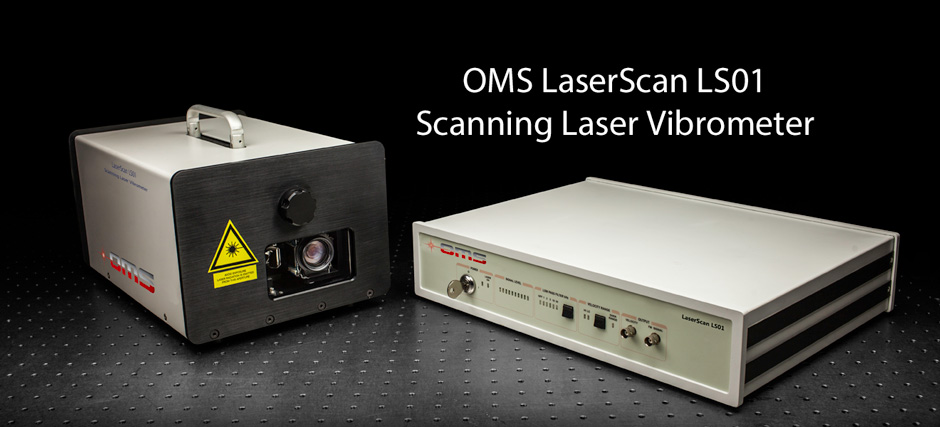
OMS LaserScan LS01 Scanning Vibrometer FAQ
- What does the system measure?
- What does the system display?
- Can it also measure displacement and acceleration?
- How would I know if the specs of the LaserScan meet my measurement requirements?
- Do I need to focus the laser beam to each target distance?
- Can the LaserScan measure vibration frequencies that are larger than 40 kHz?
- Can the LaserScan tolerate changes in signal amplitude, which may occur when particles or other obscurants block the laser beam?
- Is the laser light visible?
- What is the laser safety class?
- Do I need to mount the system on a stable table?
- How much training is required to operate the LaserScan?
- Can I do modal analysis?
- Can I use the LaserScan without the software?
- What accessories does OMS offer for the LaserScan?
1. What does the system measure?
The OMS LaserScan LS01 measures the velocity and frequency of vibration at up to 1000 points in the horizontal and vertical direction of a vibrating target spanning an angle of ±20° in each direction.
2. What does the system display?
When working in conjunction with the optional comprehensive software the OMS LaserScan enables the generation of a flexible measurement grid on the target, automatic scanning of the programmed grid, a large variety of data analysis and filtering options, and 3D animation and visualization of results.
3. Can it also measure displacement and acceleration?
Yes. Both of these parameters can be obtained in software.
4. How would I know if the specs of the LaserScan meet my measurement requirements?
There are three parameters that define the measurement requirements:
- Distance to target - For good reflecting surfaces the LaserScan can measure targets at any distance between about 0.5 m and 5 m. If the surface is not a good reflector, then the maximum distance may be less than 5 meters.
- Frequency of vibration - the LaserScan can measure frequencies from close to DC to 40 kHz.
- Velocity of vibration - This parameter has a maximum value of 0.8 m/s and may be calculated as follows: V = 2π * amplitude * frequency. For example if the amplitude of vibration were 10 microns and the frequency of vibration 1 kHz, then the velocity would be 0.063 m/s.
5. Do I need to focus the laser beam to each target distance?
No. The OMS LaserScan uses a collimated beam and does not require a focusing lens, therefore it is easy to change the target distance anywhere in the range between 0.5 m and 5 meters.
6. Can the LaserScan measure vibration frequencies that are larger than 40 kHz?
Yes. Options are available to use the LaserScan at frequencies up to 80 kHz.
7. Can the LaserScan tolerate changes in signal amplitude, which may occur when particles or other obscurants block the laser beam?
Yes. The OMS LaserScan measures optical phase changes due to target vibration. This optical phase change is manifested as a frequency modulated signal upon mixing the target signal with the reference beam local oscillator. Thus signal amplitude fluctuations will have very little effect on the signal frequency provided that the amplitude of the signal stays above a reasonable threshold. If the signal amplitude falls below the threshold then the instrument will experience a "dropout." The software will automatically dither the laser to enable repeating the measurement in the vicinity of a dropout point.
8. Is the laser light visible?
There are actually two lasers in the LaserScan. The laser making the measurement is an infrared 780nm laser. The second laser is a red 650nm laser that can be turned on and off by a switch on the back of the laser head. This red laser is used to see where the measurement is being taken. The Infrared laser light has a deep red color that can readily be seen on most targets. We also provide, at no additional charge, a laser light card to augment the visibility of the laser for those targets that are hard to see.
9. What is the laser safety class?
The infrared laser is class 3B. The total infrared laser power out of the LaserScan is about 10 mW at a wavelength of 780 nm. The red laser is class 2 and has less than 1mw of 650nm laser light.
10. Do I need to mount the system on a stable table?
No. In most applications the system may be mounted on a tripod.
11. How much training is required to operate the LaserScan?
One to two days of training should be sufficient for most customers. The training is largely driven by the complexity of the software.
12. Can I do modal analysis?
Yes. An optional modal analysis software is available that works within the regular software. You may also export the data to other software modules.
13. Can I use the LaserScan without the software?
Please contact OMS to discuss LaserScan software options.
14. What accessories does OMS offer for the LaserScan?
OMS offers either a 2-channel or 4-channel DAQ. The 2-channel DAQ is sufficient for the LaserScan since it enable recording the signal plus a reference. Additional channels may be used to monitor other devices. OMS also offers a comprehensive software package for data collection, analysis, and display, and a modal analysis package that runs within the comprehensive software.
